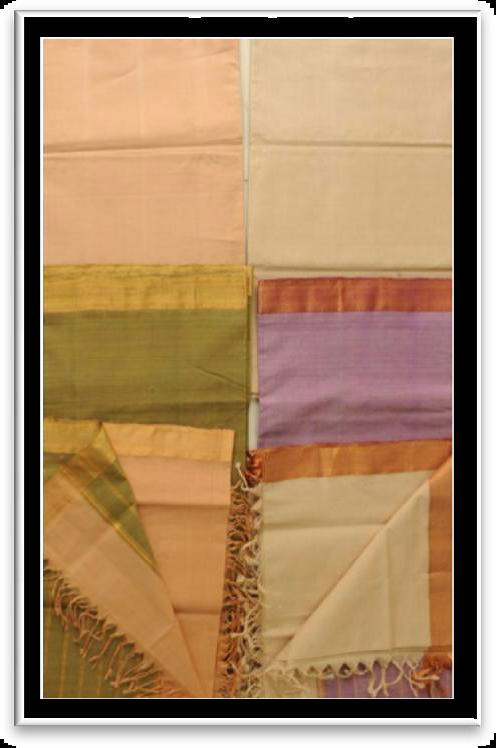Mangalagiri Sarees and Cotton Dress Material
Mangalagiri Sarees and Cotton Dress Material
Mangalagiri Saree
Background
Mangalagiri is a small town which is 19 Kilometres away from Guntur district head quarter and 12 Kilometres from Vijayawada. Mangalagiri was always known as a piligrim centre. There is a famous and elegant temple on a hillock in the heart of Mangalagiri town dedicated to Lord Panakala Narasimha Swamy. There is another temple dedicated to Lakshmi Narasimha Swamy. It is said that pilgrims were expected that to offer their respects to Lord Panakala Narasimha on the Hilltop, and then buy a saree from a local weaver before leaving the place. This clearly emphasized the patronage and impetus given to the handloom industry even as part of the tradition.
Material used
Mangalagiri saree is a fine count saree normally woven with 80s combed cotton yarn for both warp and weft with extra warp design in the border. The extra warp design is specially known as “Nizam Border”. The speciality of the extra warp design is a combination of twill, rib and diamond weaves and these weaves are arranged side by side continuously without any gap and that too design starts from the edge of the selvedge without leaving a single thread. Zari is used for extra warp design in the borders. Mangalagiri sarees are made in resplendent colours and also in vibrant shot colours
Technique used
Mangalagiri sarees are woven on pit looms with dobby attachment. Nylon clasped healds and roller shedding mechanism are used for getting proper shedding. For getting heavy texture, one middle rest (dandi) is kept in between cloth beam and warp beam at a higher level. Pocker rod take- up and rope let-off motion are arranged. 8 and 12 lever barrel dobby are used for weaving extra warp Nizam border design.
How to distinguish genuine Mangalagiri Saree
- Basic texture is more compact than that of similar cotton sarees.
- Extra warp design are spread continuously without any gap upto the selvedge of the saree.
- The texture of the saree is relatively soft since there is no starch finish.
- Mangalagiri saree do not have any extra weft designs on the body.
Mangalagiri Cotton Dress Material
Mangalagiri is a small town which is 19 Kilometres away from Guntur district head quarter and 12 Kilometres from Vijayawada. Mangalagiri was always known as a pilgrim centre.
There is a famous and elegant temple on a hillock in the heart of Mangalagiri town dedicated to Lord Panakala Narasimha Swamy. There is another temple dedicated to Lakshmi Narasimha Swamy. It is said that pilgrims were expected that to offer their respects to Lord Panakala Narasimha on the Hilltop, and then buy a saree from a local weaver before leaving the place. This clearly emphasized the patronage and impetus given to the handloom industry even as part of the tradition.

Material used
Mangalagiri cotton dress material is a fine count fabric normally woven with 80s combed cotton yarn for both warp and weft.
The speciality of the extra warp design is a combination of twill, rib and diamond weaves and these weaves are arranged side by side continuously without any gap and that too design starts from the edge of the selvedge without leaving a single thread.
Zari is used for extra warp design in the borders.
Technique used
Mangalagiridress materials are woven on pit looms with dobby attachment. Nylon clasped healds and roller shedding mechanism are used for getting proper shedding. For getting heavu texture, one middle rest (dandi) is kept in between cloth beam and warp beam at a higher level. Pocker rod take- up and rope let-off motion are arranged.
How to distinguish genuine Mangalagiri dress material
- Basic texture is more compact than that of similar cotton sarees.
- Extra warp design are spread continuously without any gap upto the selvedge of the saree.
- The texture of the fabric is relatively soft since there is no starch finish.
- Mangalagiridress material do not have any extra weft designs on the body.
Source : India Handloom Brand
Last Modified : 9/6/2023
This topic provides information about Maheshwari S...
This topic provides information about Kani Pashmin...
This topic provides information about Shantipuri C...
This topic provides information about Chettinadu D...
